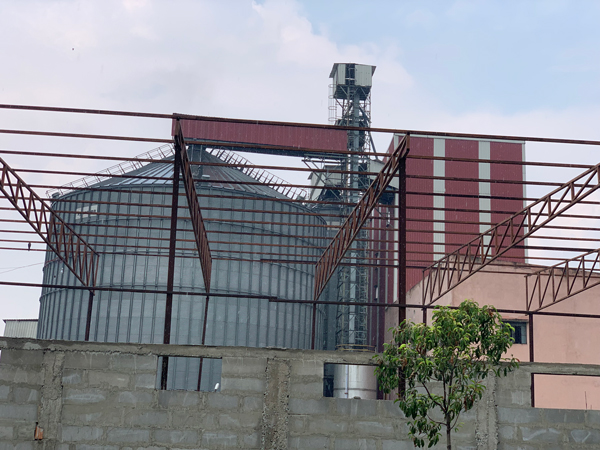Project Description
M/s Henraajh Feeds India Pvt. Ltd. is a private limited company, having registered office at Neem Ghat, Water Tank Road, Khajekalan, Patna (Bihar). The company proposes to set up a poultry feed unit at Plot No. S-1, S-2, S-3, S-9, S-10 & S-11, Industrial Area, Fatuha, Patna (Bihar). The company has taken above area on leasehold basis from BIADA.
Project Component
- Modern poultry feed plant of 15 MT/hr. Capacity.
- 1 Silo having capacity of 5000MT & 2 Silo of 350 MT Each.
- Raw Material Godown of area 5700 Sq. Ft. and Finished Goods of area 8210 Sq. Ft.

Project Details
Generally, two types of poultry feed are prepared. One is ready-made and in the form of mash or pellets. The second is in concentrated form to be mixed with an energy source. Concentrates are protein source, balanced in amino acid and containing vitamins, minerals and feed activities. They are mixed with energy source such as maize, sorghum or Bajra to Prepare poultry rations.
There are several different kinds of feeds available in the market. Each brand-name feed may have slightly different requirements and different ingredients and protein and other nutrient content.
There are three basic of Poultry Feed:
- "Pelleted Feeds" These are concentrates of high quality grains ingredients with vitamins and minerals as additions.
- "Crumbles" pellets are broken" making it easier for poultry to eat. Just like pellets these are concentrates of high quality grain ingredients with vitamins and minerals as additions.
- "Mash" crumbles are "smashed" to make a "meal". Concentrates of high quality grain ingredients with vitamins and minerals added.
However, The Company will produce only one currently i.e. Pellet.
Feed standards and specifications
For cattle and poultry, nutritional standards have been prepared with respect to the genotype, environment and quality of available raw materials, maintenance methods, production and reproduction requirements, production capacity and phase of production. The Bureau of Indian Standard (BIS) is a central government organization that facilitates discussion between scientists and industry and prepares guideline and specifications.
BIS standards, poultry feed requirements for minerals, fatty acids, amino acids and vitamins.
Characteristic |
Broiler Starter |
Broiler finisher feed |
Chick |
Growing chicken feed |
Laying chicken feed |
Breeder layer feed |
Manganese(mg/kg) |
90 |
90 |
90 |
50 |
55 |
90 |
Iodine (mg/kg) |
1 |
1 |
1 |
1 |
1 |
1 |
Iron (mg/kg) |
120 |
120 |
120 |
90 |
75 |
90 |
Zinc (mg/kg) |
60 |
60 |
60 |
50 |
75 |
100 |
Copper (mg/kg) |
12 |
12 |
12 |
9 |
9 |
12 |
Vitamins A (IU/kg) |
6000 |
6000 |
6000 |
6000 |
8000 |
8000 |
Vitamin D3 (IU/kg) |
600 |
600 |
600 |
600 |
1200 |
1200 |
Thiamine (mg/kg) |
5 |
5 |
5 |
3 |
3 |
3 |
Riboflavin (mg/kg) |
6 |
6 |
6 |
5 |
5 |
5 |
Pantothenic acid (mg/kg) |
15 |
15 |
15 |
15 |
15 |
15 |
Nicotinic acid (mg/kg) |
40 |
40 |
> 40 |
15 |
15 |
15 |
Biotin (mg/kg) |
0.2 |
0.2 |
0.02 |
0.15 |
0.15 |
0.20 |
Vitamin B12 (mg/kg) |
0.015 |
0.015 |
0.015 |
0.01 |
0.010 |
0.10 |
Folic acid(mg/kg) |
1.0 |
1.0 |
1.0 |
0.5 |
0.5 |
0.5 |
Choline (mg/kg) |
1400 |
1000 |
1300 |
900 |
800 |
800 |
Vitamin E (mg/kg) |
15 |
15 |
15 |
10 |
10 |
10 |
Vitamin K (mg/kg) |
1.0 |
1.0 |
1.0 |
1.0 |
1.0 |
1.0 |
Pyridoxine (mg/kg) |
5 |
5 |
5 |
5 |
5 |
5 |
Linoleic acid (g/100g) |
1 |
1 |
1 |
1 |
1 |
1 |
Methionine + c ystine (g/100g) |
0.9 |
0.7 |
0.6 |
0.5 |
0.55 |
0.55 |
Source: BIS. Poultry feeds - specifications, fourth revision.
Poultry feed is divided into layer and broiler feed. In the case of layer feed, cost is the main constraints in using compound feed. An innovative, high-value compound feed can result in increased number of eggs, but the risks are too high because of the birds′ long life cycle. Compound feed has, however, made a major contribution to broiler feeding. This is an example of excellent coordination among instrument technology, formulation and use of feed additives and supplements. Cost is a less important factor because the performance improvements are greater than the cost increases and the birds′ lifecycle is short.